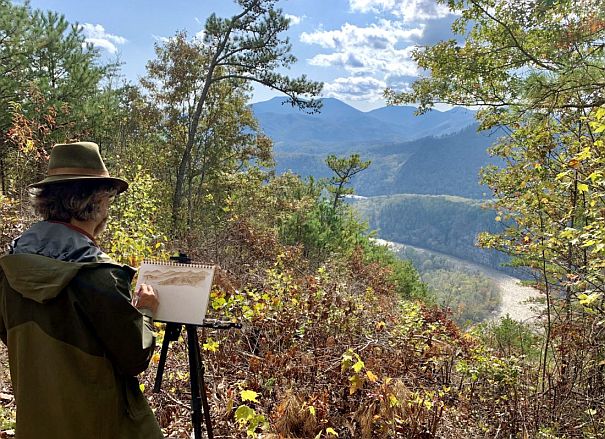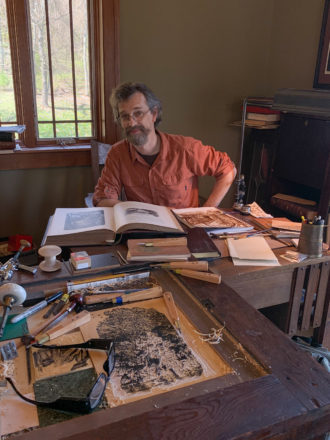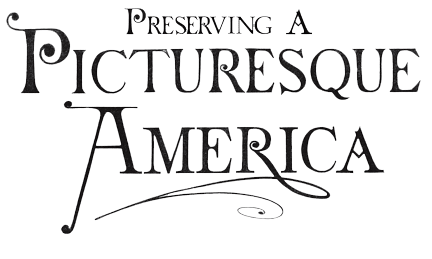
Posted on April 15, 2021 by Thomas Calder
Happenstance led Asheville artist and printmaker Scott “Doc” Varn to establish Preserving a Picturesque America, a local nonprofit that promotes conservation efforts through the arts.
More than a decade ago, Varn came across an online estate auction. While scrolling through its inventory, he noticed a woodblock print of a familiar waterway — the French Broad River. Enamored by the design, Varn purchased the item, but his infatuation was dimmed upon the print’s arrival when he realized the image had been sliced out of a book — a grave taboo, according to the printmaker’s worldview. “I was disgusted,” he says.

AMERICA THE BEAUTIFUL: For over a decade, Scott “Doc” Varn has traveled the country visiting sites featured in Picturesque America, an 1870s publication that documented the country’s natural wonders. Currently, Varn is working with local artists to reinterpret 12 WNC locations featured in the series. Photo by Sam Varn
But curiosity soon eclipsed his repulsion. “It made me ask questions,” he says. Primarily, “What book did this come from?”
18-pound monsters
Research revealed that the print was part of Picturesque America, a series published by Appleton Press in the 1870s. Released in 48 parts, the collection was eventually bound into two volumes featuring over 900 engravings.
While few copies survive today, Varn was fortunate to discover both volumes — which he describes as “18-pound monsters” — at The Captain’s Bookshelf, long before the store closed its downtown brick-and-mortar in 2020 (it continues to maintain an online shop).
“I’m getting chills right now just thinking about how monstrously huge of a moment that was,” Varn says of the purchase.
A decade later, that occasion continues to direct and influence Varn’s life. Initially, he set out to document the books’ featured locations during family vacations. But as he shared his plans with friends, Varn was encouraged to expand the project into what it’s become — a coalition of artists working to recapture the more than 900 sites as they appear today.
“Before we die, our job is to get 1,000 pieces of art created,” Varn says.
Western North Carolina is the launch pad for Preserving a Picturesque America’s mission. Working with local artists, historians and conservationists, the nonprofit’s first group exhibit/fundraiser is set for September, though a location has not been finalized. A portion of the money raised will go toward restoring and protecting the 12 local sites featured in Preserving America, with remaining funds supporting the expansion of the project throughout the continental United States.
Graffiti and litter
Not surprisingly, plenty has changed — both locally and nationally — since the series first published. Today, highways bisect some of the collection’s featured landscapes; industrial buildings obscure others.
“We’ve not always been good stewards,” says Varn.
The most heartbreaking example for the nonprofit leader is Paint Rock outside Hot Springs. The location is home to the state’s best-known American Indian pictograph, featured among the engravings in Picturesque America. Today, Paint Rock is defaced with graffiti, and its surrounding area is fouled with litter — issues Preserving a Picturesque America is working to address through cleanup sessions.
“It makes me sad for the people that I love in Western North Carolina,” says Varn. “Why would anyone do this?”
But the thrills outweigh the heartache for many of the project’s volunteers. Finding a location from the original publication is a rush for seekers like architect and Madison County historian Taylor Barnhill and local author Jacqueline Painter, who have scouted several of the 12 WNC sites featured in the collection.
The pair have trekked through unkempt trails and underbrush to reach several locations that are pictured completely treeless in Picturesque America. The earlier deforestation, says Barnhill, was due to livestock. Most of the local areas depicted in the publication were along Drover’s Road, a route that ran parallel to the French Broad River along which 19th-century Kentuckians and Tennesseans drove cows, pigs and chickens to South Carolina markets. Capitalizing on these annual expeditions, many area farmers cleared their land and cultivated corn to sell to the drovers as feed.
“A lot of these sites today have returned to forest and wild areas,” Barnhill explains.
Indiana Jones moment
Among the most rewarding finds for Barnhill and Taylor was an iron eyebolt at the edge of Hot Springs. The discovery helped pinpoint the site of a former ferry crossing featured in the series.

VOLUME ONE: Scott “Doc” Varn looks through his copy of Picturesque America at his home studio. Photo by Sam Varn
“It’s an Indiana Jones feeling,” says Barnhill. “You have these clues, and you’re kind of a cross between a detective and a scavenger hunter. The clues begin to fall into place, and then one day you come across the site and perspective you’ve been looking for.”
Like his volunteers, Varn relishes the act of discovery.“It is an amazing, exhilarating moment when you find the exact vantage point where an artist stood 150 years ago,” he says. “There’s nothing I can do to describe the joy in that.”
As fellow artists experience similar thrills while reinterpreting these sites for the upcoming fall exhibit, Varn notes the importance of representing what stands today rather than what stood 150 years prior. Often, he explains, artists want to re-create what is shown in the original publications. But Varn hopes that by pairing the old with the new, he can inspire greater awareness and participation in the conservation movement.
“It’s always a challenge,” he says. “Artists want to emotionally edit out certain things. But I encourage them to paint it as it is — be it with a new road, new structure or trees coming back in.”
Seeing is believing
“Art is a kind of magic,” says Judy Mattox, the group’s executive committee chair. “It often speaks like music to the ear, whereas lectures don’t necessarily have that voice.”
The group hosted Scott “Doc” Varn in February 2020 for one of its last in-person monthly meetings prior to COVID-19 restrictions. The event marked Varn’s first major public appeal for artists to join Preserving a Picturesque America’s mission.
“You can’t conserve what you don’t know,” Mattox says. “Doc’s purpose is to make people aware of the French Broad basin and to try and educate people to preserve the best way they can.”
The Sierra Club continues to hold monthly virtual meetings on the first Thursday of each month. To learn about upcoming events, visit avl.mx/977.
